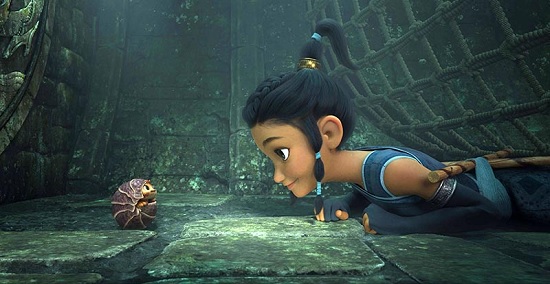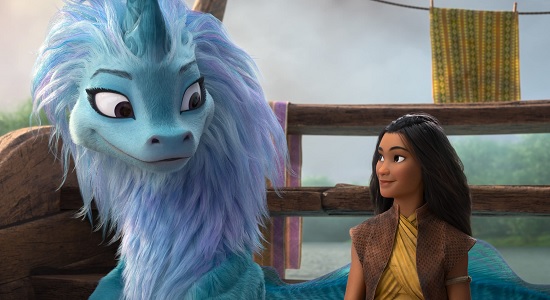
Starring: Kelly Marie Tran, Awkwafina, Gemma Chan, Daniel Dae-Kim & Benedict Wong
Directed by: Don Hall & Carlos López Estrada
Animated by: Walt Disney Animation Studios
Release Date: March 2021
Running Time: 107 mins
59th ‘Disney Classics’ Film from Walt Disney Animation Studios
Synopsis: Long ago, in the fantasy world of Kumandra, humans and dragons lived together in harmony. However, when sinister monsters known as the Druun threatened the land, the dragons sacrificed themselves to save humanity. Now, 500 years later, those same monsters have returned, and it’s up to a lone warrior to track down the last dragon and stop the Druun for good.
Ever since it released Snow White and the Seven Dwarves back in 1937, Walt Disney Animation Studios has been considered the gold standard in feature-length animation; and while it might have had declines in popularity over the decades, it has also had frequent renaissance and reinventions too. For me, a child growing up in the late-80s, Walt Disney Animation Studios’ feature-films were the soundtrack to my childhood. I remember owning the big boxed VHS tapes of The Little Mermaid, Beauty and the Beast, The Rescuers Down Under, The Lion King and Aladdin. The quality of the films might have suffered throughout the late-90s and early-2000s, especially with the advent of Pixar and computer-generated animation, but recent releases such as Tangled, Frozen and Moana have seen Walt Disney Animation Studios revitalised for a new generation.
Along with embracing computer-generated animation, another way that the studio has reinvigorated itself has been its recent willingness to explore more diverse voices and backgrounds in its films; The Princess and the Frog introduced its first African-American Princess; Moana explored Polynesian mythology, and Raya and the Last Dragon is immersed in Southeast Asian culture.
The world of Raya and the Last Dragon is one of the film’s most distinctive elements; the five fractured lands that make up Kumandra each have their own unique climate and identity – not only representing the multi-cultural diversity found within Southeast Asia, but also providing a rich tapestry for the film’s central ‘quest’ narrative to explore. It was this quest-like structure to the plot that really drew me into the film, distinguishing it from the majority of Walt Disney Animation Studios’ other releases. The film further diverges from the classic ‘Disney format’ by not featuring original songs and musical interludes, and by purposefully excluding a love interest for Raya. These changes give Raya and the Last Dragon a fresh and exciting feel, mirroring some of the stylistic choices we’ve seen from Pixar over the past few years and further closing the gap between the two Disney-owned studios.

While there has always been a degree of magic and fantasy in the fairy-tale inspired movies of Walt Disney Animation Studios, Raya and the Last Dragon veers more heavily into hard fantasy with its fictional realm of Kumandra, which is subsequently destroyed by the dark spirits of the Druun. In the aftermath of a post-apocalyptic disaster which has seen the populace decimated and turned into stone, those who remain must survive against these mindless spirits, or risk becoming turned into statues also. It is the closest to a zombie apocalypse that Disney will ever get, and it gives the film a real sense of danger throughout. The Druun are positioned as a real threat, and it feels like our merry band of misfit heroes are the last chance to save humanity before it is extinguished. Post-apocalyptic settings in movies and TV are typically viewed through a Western lens, taking place in either the USA or UK, so it is refreshing to see an Asian-inspired wasteland, especially with its curious blend of past and future technologies. Much like how Black Panther and Black Panther: Wakanda Forever offered a fresh and exciting take on African culture, Raya and the Last Dragon encourages audiences to look at Southeast Asian culture in a whole new way.
Raya, as a character, embodies plenty of positive feminist values as a modern-day ‘Disney Princess’. Not only is she self-sufficient and not reliant on a male protagonist to save her, she is also extremely focused on her goal to save the people of Kumandra. The film digs deeply into her feelings of survivor guilt and her inability to trust others as a result of her childhood experiences, addressing how these flaws negatively affect her decision-making. The great water-dragon Sisu offers an optimistic counter to Raya’s cynicism and through their friendship, the pair manage to learn something about the value of trust. During their adventure to unite the broken pieces of the Dragon gem and banish the Druun, the pair meet a number of other quirky characters from the post-apocalyptic regions of Kumandra, each representing one of the five lands. Without realizing, Raya places her trust in her newfound friends and achieves her father’s goal of reuniting the separate tribes of Kumandra as one nation.

Kelly Marie Tran voices Raya, imbuing the character with a strong personality and singlemindedness that gradually softens as she learns to rely on others. It is a fantastic character arc, and Tran’s performance is wonderfully subtle and acts as the foundation for the film. She is joined by Awkwafina as the water-dragon Sisu, who is extremely reminiscent of Robin Williams’ Genie from Aladdin and Eddie Murphy’s Mushu from Mulan, in the way that she makes occasional pop culture references and non-sequiturs to add some levity to the plot. While initially she seems to be out of step with the darker tone of the film, the character is developed deeper towards the middle of the film and she shares a similar survivor’s guilt to Raya, albeit one that is underscored by trust in others as opposed to Raya’s distrustful nature. Gemma Chan voices Namaari, Raya’s rival and one of the antagonists for the film; she acts as a very interesting mirror image to Raya, equally as distrustful and their rivalry/friendship takes the place of the typical romance sub-plot. Some viewers have seen this as a metaphor for a possible lesbian relationship, proving that people will see patterns in anything, but I really liked how the film eschewed the typical love interest for a different type of dynamic.
With Raya and the Last Dragon, we might be reaching the peak of what we can achieve with computer-generated animation. I can’t imagine any other animated film looking better than this one does. The varied mix of biomes that form the five lands of Kumandra allows animators to showcase a mix of climates and landscapes including deserts, snowy mountains and lush forests, with each one looking incredibly realistic and impressive. The film embraces its Southeast Asian influences to their fullest through the use of its dragon mythologies and its vibrant backdrops. The lack of musical interludes and princely love interests helps maintain the gravitas of the storyline, which is surprisingly bleak for a Disney animated film. Eschewing the animation studio’s long-established tropes in favour of telling an original story in a fresh way allows Raya and the Last Dragon to really stand out from the crowd, not just because of its strong feminist message and diverse representation, but also because it is an extremely well-constructed fantasy adventure.
Score – ★★★★ ½
Raya and the Last Dragon is available on Blu-Ray and DVD from Amazon UK, as well as available to stream on Disney+.


